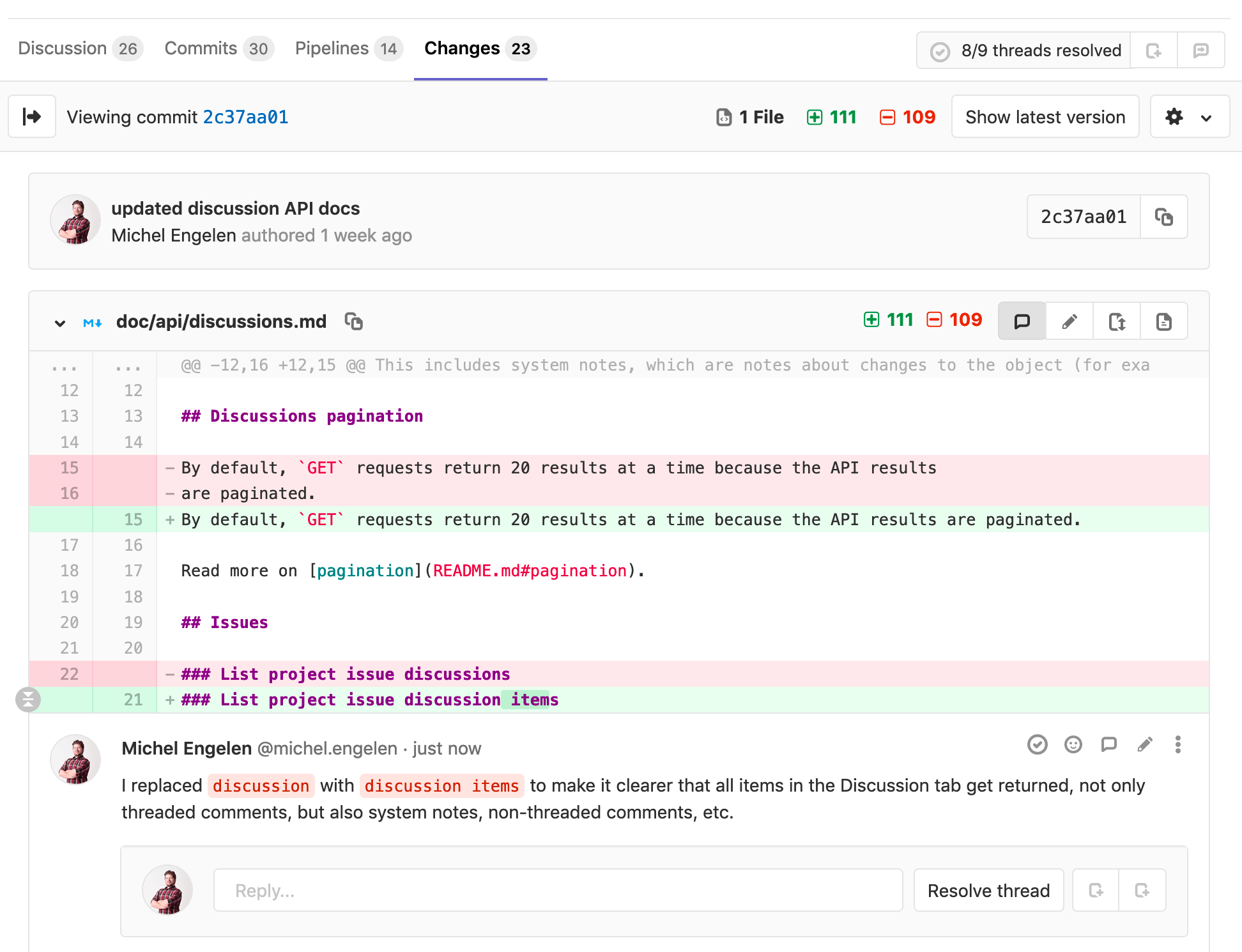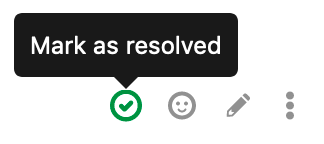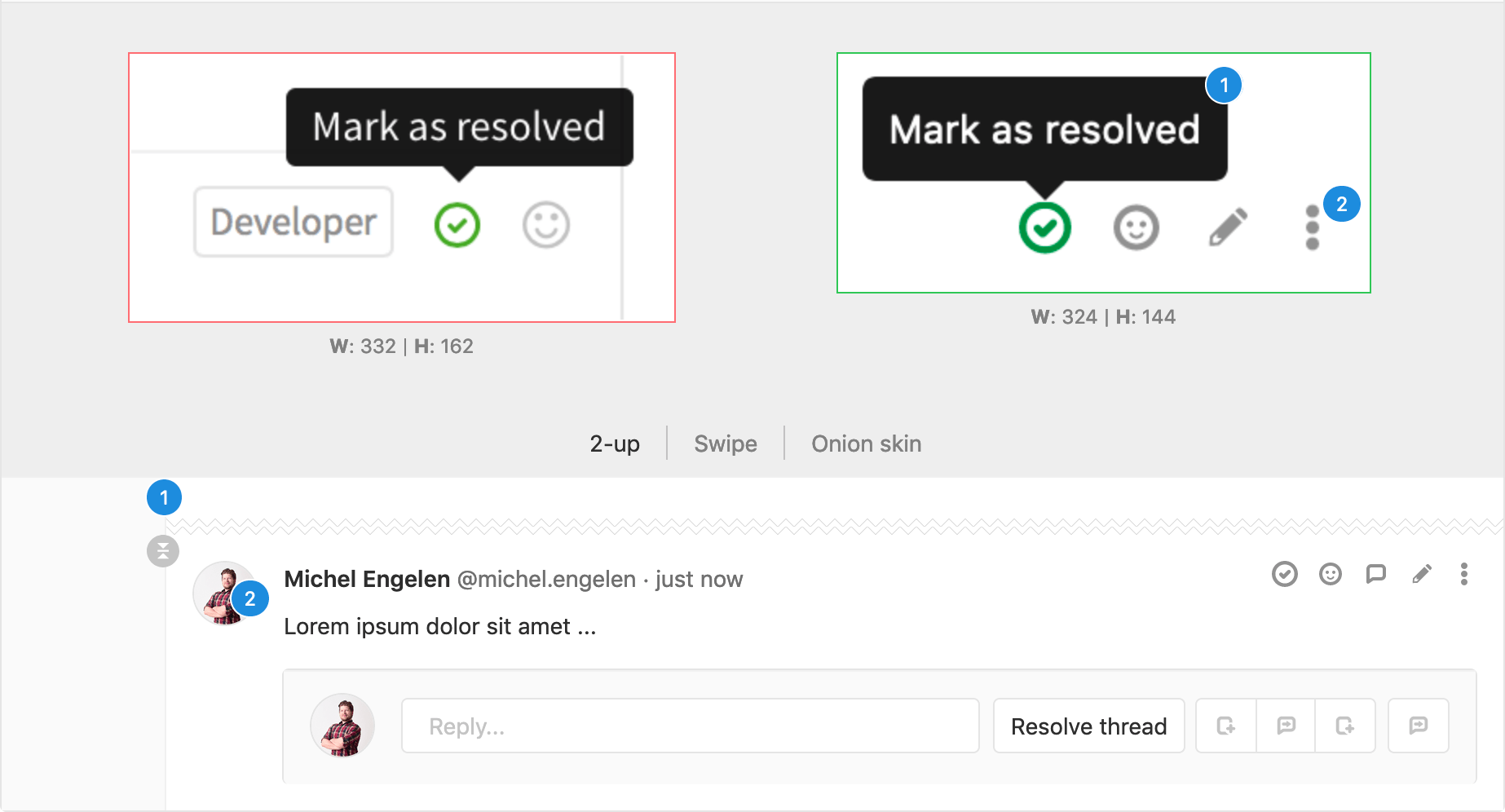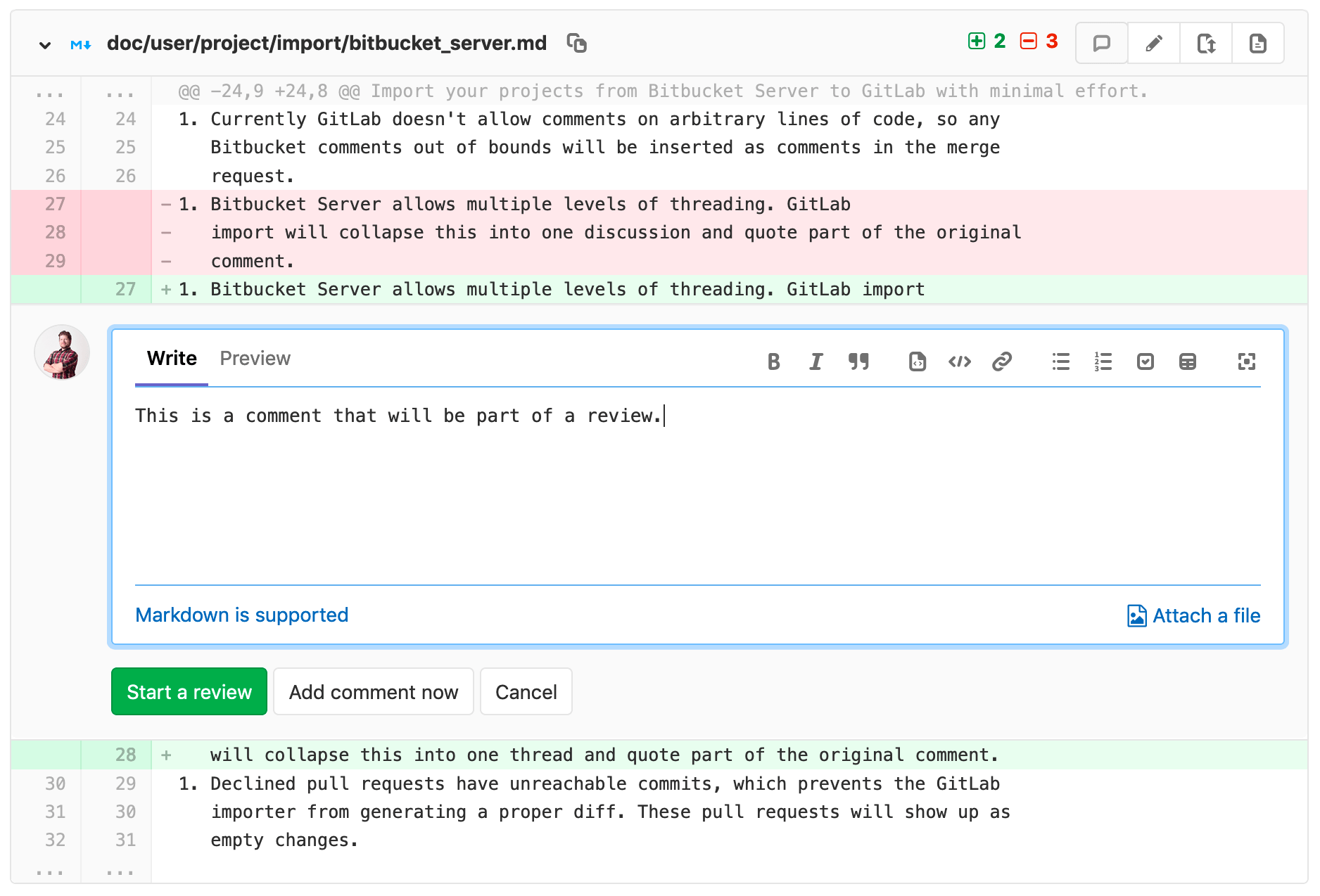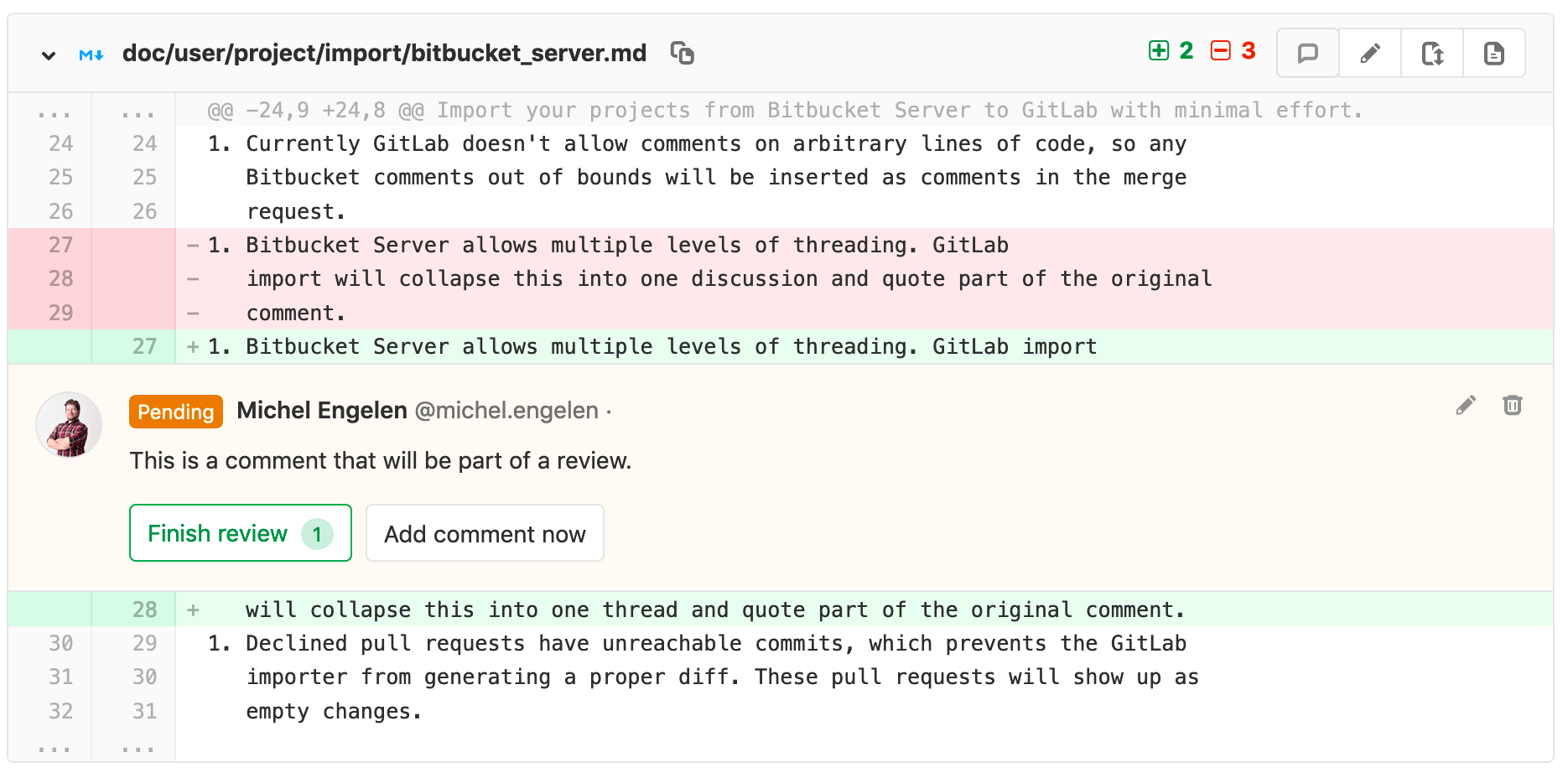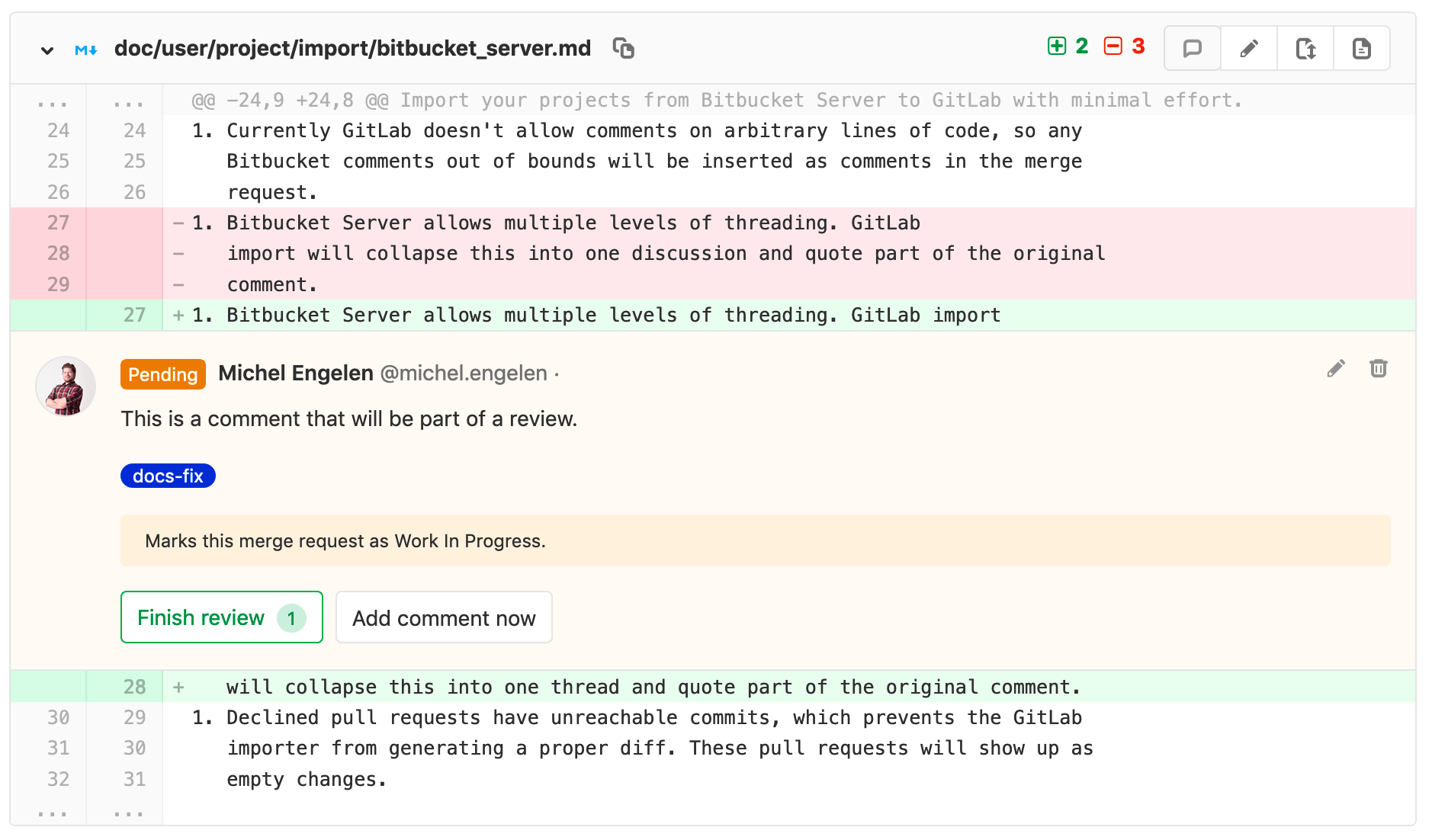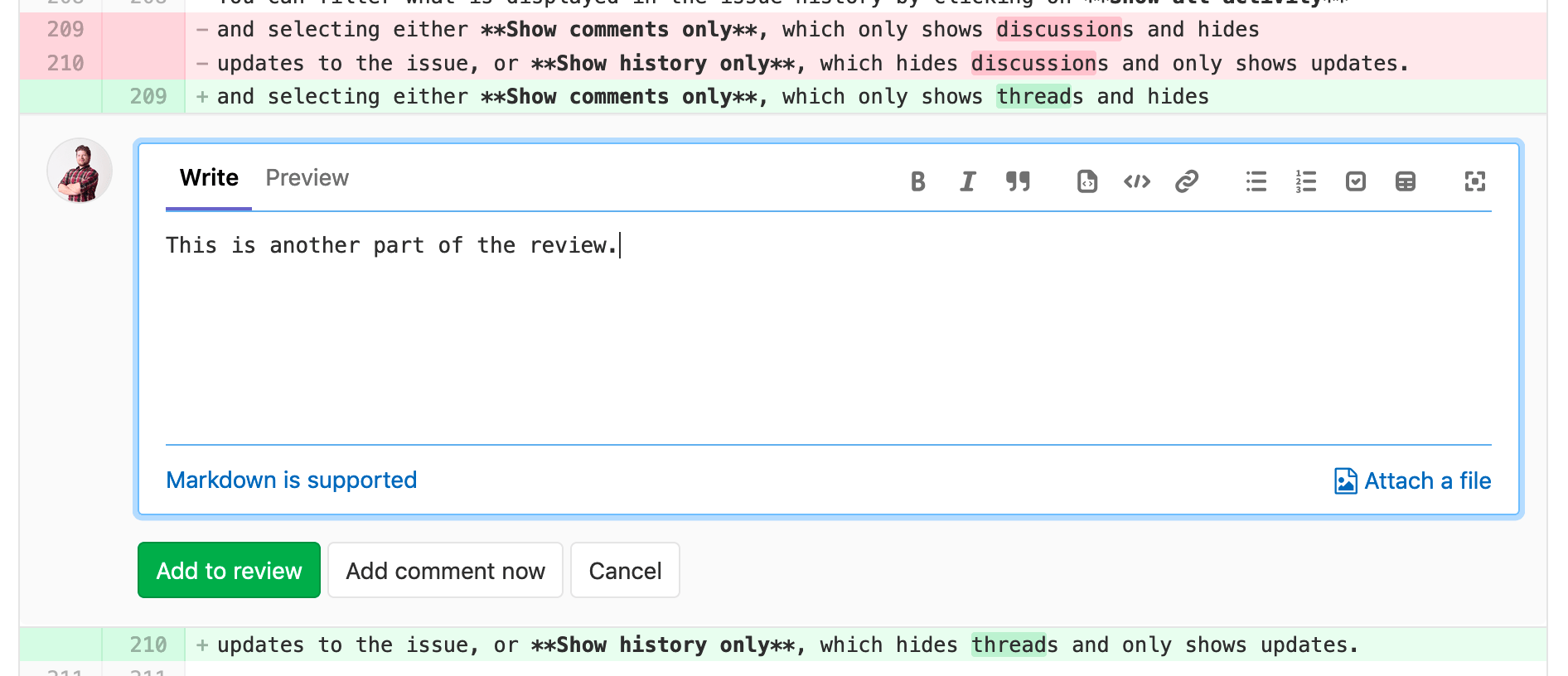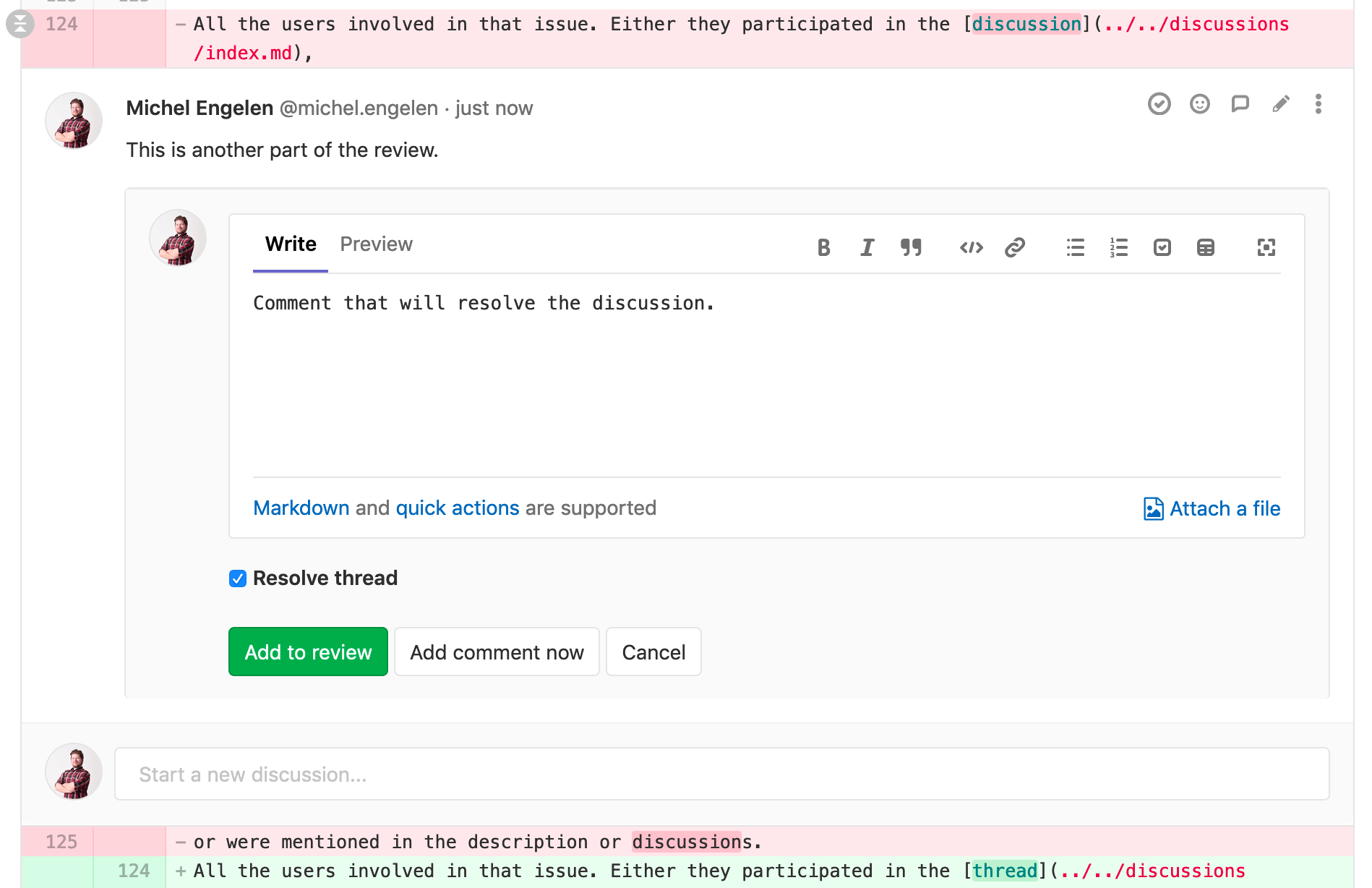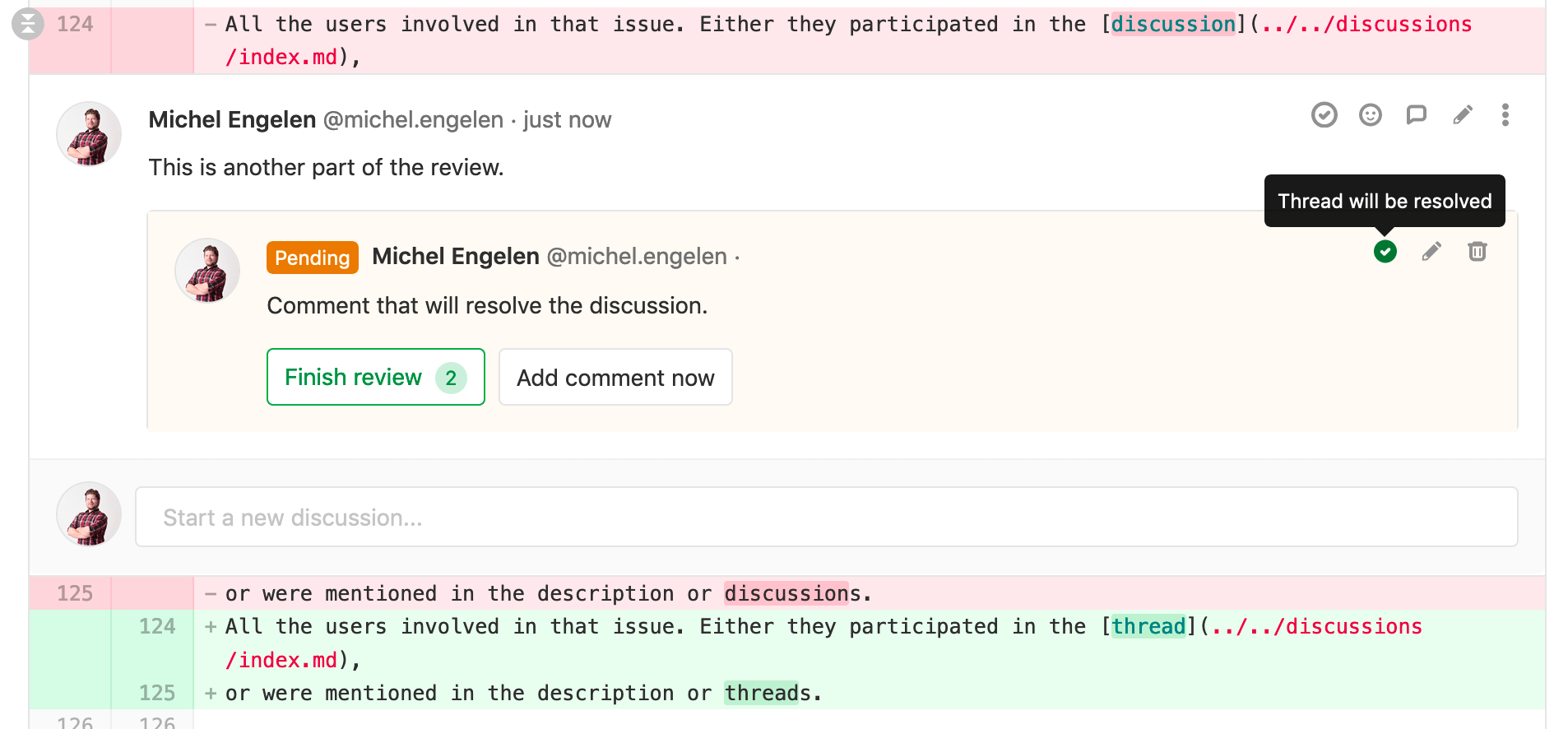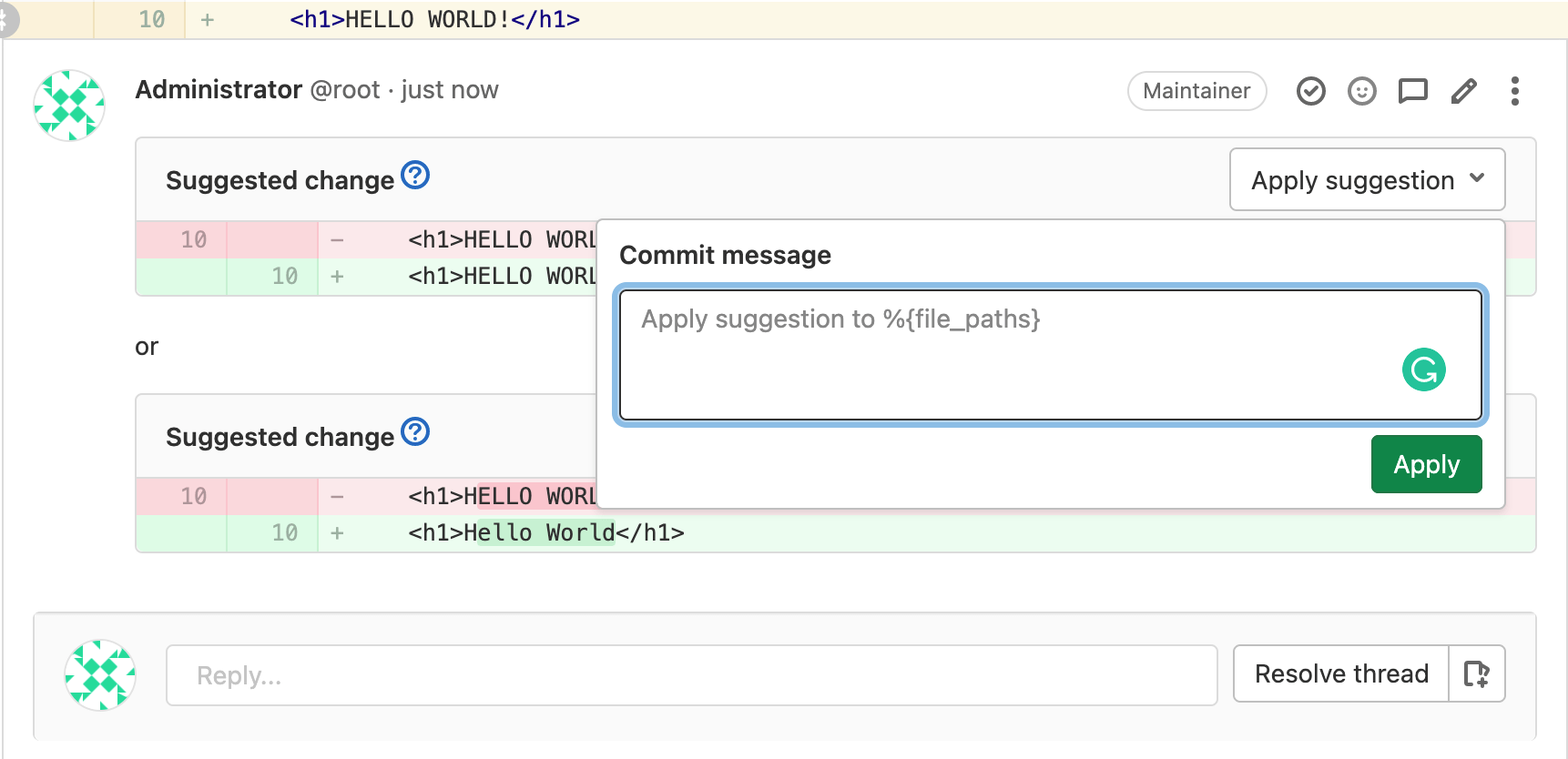24 KiB
| stage | group | info | type |
|---|---|---|---|
| Create | Code Review | To determine the technical writer assigned to the Stage/Group associated with this page, see https://about.gitlab.com/handbook/engineering/ux/technical-writing/#assignments | reference, howto |
Threads (FREE)
GitLab encourages communication through comments, threads, and suggestions.
For example, you can create a comment in the following places:
- Issues
- Epics
- Merge requests
- Snippets
- Commits
- Commit diffs
There are standard comments, and you also have the option to create a comment in the form of a thread. A comment can also be turned into a thread when it receives a reply.
The comment area supports Markdown and quick actions. You can edit your own comment at any time, and anyone with Maintainer access level or higher can also edit a comment made by someone else.
You can also reply to a comment notification email to reply to the comment if Reply by email is configured for your GitLab instance. Replying to a standard comment creates another standard comment. Replying to a threaded comment creates a reply in the thread. Email replies support Markdown and quick actions, just as if you replied from the web.
NOTE: There is a limit of 5,000 comments for every object, for example: issue, epic, and merge request.
Resolvable comments and threads
- Introduced in GitLab 8.11.
- Resolvable threads can be added only to merge request diffs.
- Resolving comments individually was removed in GitLab 13.6.
Thread resolution helps keep track of progress during planning or code review.
Every thread in merge requests, commits, commit diffs, and snippets is initially displayed as unresolved. They can then be individually resolved by anyone with at least Developer access to the project or by the author of the change being reviewed. If the thread has been resolved and a non-member un-resolves their own response, this also unresolves the discussion thread. If the non-member then resolves this same response, this resolves the discussion thread.
The need to resolve threads prevents you from forgetting to address feedback and lets you hide threads that are no longer relevant.
Commit threads in the context of a merge request
For reviewers with commit-based workflow, it may be useful to add threads to specific commit diffs in the context of a merge request. These threads persist through a commit ID change when:
- force-pushing after a rebase
- amending a commit
To create a commit diff thread:
-
Navigate to the merge request Commits tab. A list of commits that constitute the merge request are shown.
-
Navigate to a specific commit, select the Changes tab (where you are only be presented diffs from the selected commit), and leave a comment.
-
Any threads created this way are shown in the merge request's Discussions tab and are resolvable.
Threads created this way only appear in the original merge request and not when navigating to that commit under your project's Repository > Commits page.
NOTE: When a link of a commit reference is found in a thread inside a merge request, it is automatically converted to a link in the context of the current merge request.
Marking a comment or thread as resolved
You can mark a thread as resolved by clicking the Resolve thread button at the bottom of the thread.
Alternatively, you can mark each comment as resolved individually.
Move all unresolved threads in a merge request to an issue
To continue all open threads from a merge request in a new issue, click the Resolve all threads in new issue button.
Alternatively, when your project only accepts merge requests when all threads are resolved, an open an issue to resolve them later link displays in the merge request widget.
This prepares an issue with its content referring to the merge request and the unresolved threads.
Hitting Create issue causes all threads to be marked as resolved and add a note referring to the newly created issue.
You can now proceed to merge the merge request from the UI.
Moving a single thread to a new issue
To create a new issue for a single thread, you can use the Resolve this thread in a new issue button.
This directs you to a new issue prefilled with the content of the thread, similar to the issues created for delegating multiple threads at once. Saving the issue marks the thread as resolved and add a note to the merge request thread referencing the new issue.
Only allow merge requests to be merged if all threads are resolved
You can prevent merge requests from being merged until all threads are resolved.
Navigate to your project's settings page, select the Only allow merge requests to be merged if all threads are resolved check box and hit Save for the changes to take effect.
From now on, you can't merge from the UI until all threads are resolved.
Automatically resolve merge request diff threads when they become outdated
You can automatically resolve merge request diff threads on lines modified with a new push.
Navigate to your project's settings page, select the Automatically resolve merge request diffs threads on lines changed with a push check box and hit Save for the changes to take effect.
From now on, any threads on a diff are resolved by default if a push makes that diff section outdated. Threads on lines that don't change and top-level resolvable threads are not automatically resolved.
Commit threads
You can add comments and threads to a particular commit under your project's Repository > Commits.
WARNING: Threads created this way are lost if the commit ID changes after a force push.
Threaded discussions
While resolvable threads are only available to merge request diffs, threads can also be added without a diff. You can start a specific thread which looks like a thread, on issues, commits, snippets, and merge requests.
To start a threaded discussion, select the Comment button toggle dropdown, select Start thread, and then select Start thread when you're ready to post the comment.
This posts a comment with a single thread to allow you to discuss specific comments in greater detail.
Image threads
Sometimes a thread is revolved around an image. With image threads, you can easily target a specific coordinate of an image and start a thread around it. Image threads are available in merge requests and commit detail views.
To start an image thread, hover your mouse over the image. Your mouse pointer should convert into an icon, indicating that the image is available for commenting. Simply click anywhere on the image to create a new thread.
After you select the image, a comment form is displayed that would be the start of your thread. After you save your comment, a new badge is displayed on top of your image. This badge represents your thread.
NOTE: This thread badge is typically associated with a number that is only used as a visual reference for each thread. In the merge request thread tab, this badge is indicated with a comment icon, because each thread renders a new image section.
Image threads also work on diffs that replace an existing image. In this diff view mode, you can toggle the different view modes and still see the thread point badges.
| 2-up | Swipe | Onion Skin |
|---|---|---|
 |
 |
 |
Image threads also work well with resolvable threads. Resolved threads on diffs (not on the merge request discussion tab) appear collapsed on page load and have a corresponding badge counter to match the counter on the image.
Lock discussions
For large projects with many contributors, it may be useful to stop threads in issues or merge requests in these scenarios:
- The project maintainer has already resolved the thread and it is not helpful for continued feedback.
- The project maintainer has already directed new conversation to newer issues or merge requests.
- The people participating in the thread are trolling, abusive, or otherwise being unproductive.
In these cases, a user with Developer permissions or higher in the project can lock (and unlock) an issue or a merge request, using the "Lock" section in the sidebar. For issues, a user with Reporter permissions can lock (and unlock).
| Unlock | Lock |
|---|---|
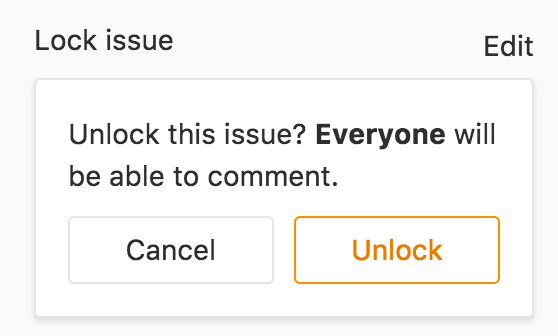 |
 |
System notes indicate locking and unlocking.
In a locked issue or merge request, only team members can add new comments and edit existing comments. Non-team members are restricted from adding or editing comments.
| Team member | Non-team member |
|---|---|
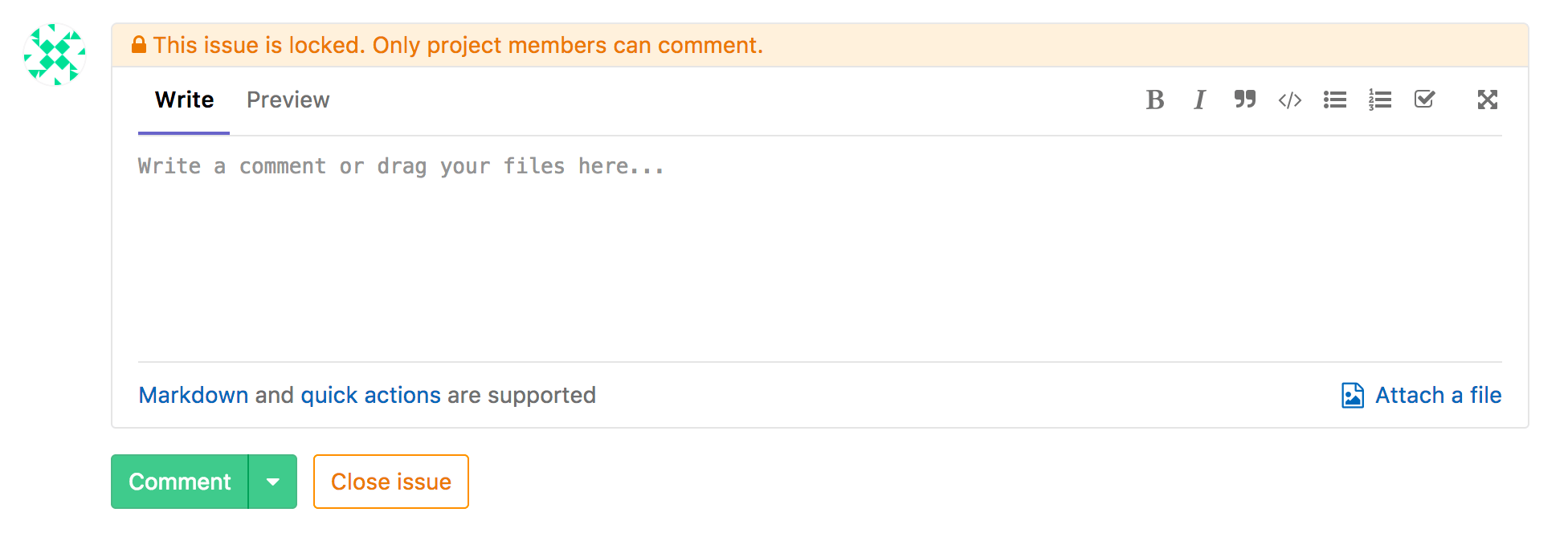 |
 |
Additionally, locked issues and merge requests can't be reopened.
Confidential Comments
- Introduced in GitLab 13.9.
- Deployed behind a feature flag, disabled by default.
- Disabled on GitLab.com.
- Not recommended for production use.
- To use in GitLab self-managed instances, ask a GitLab administrator to enable it. (FREE SELF)
WARNING: This feature might not be available to you. Check the version history note above for details.
When creating a comment, you can make it visible only to the project members (users with Reporter and higher permissions).
To create a confidential comment, select the Make this comment confidential check box before you submit it.
Merge request reviews
- Introduced in GitLab Premium 11.4.
- Moved to GitLab Free in 13.1.
When looking at a merge request diff, you are able to start a review. This allows you to create comments inside a merge request that are only visible to you until published, in order to allow you to submit them all as a single action.
Starting a review
To start a review, write a comment on a diff as normal under the Changes tab in a merge request, and then select Start a review.
After a review is started, any comments that are part of this review are marked Pending.
All comments that are part of a review show two buttons:
- Finish review: Submits all comments that are part of the review, making them visible to other users.
- Add comment now: Submits the specific comment as a regular comment instead of as part of the review.
You can use quick actions inside review comments. The comment shows the actions to perform after publication.
To add more comments to a review, start writing a comment as normal and click the Add to review button.
This adds the comment to the review.
Resolving/Unresolving threads
Review comments can also resolve/unresolve resolvable threads. When replying to a comment, a checkbox is displayed that you can click to resolve or unresolve the thread after publication.
If a particular pending comment resolves or unresolves the thread, this is shown on the pending comment itself.
Adding a new comment
Introduced in GitLab 13.10.
If you have a review in progress, you will be presented with the option to Add to review:
Submitting a review
If you have any comments that have not been submitted, a bar displays at the bottom of the screen with two buttons:
- Pending comments: Opens a list of comments ready to be submitted for review.
- Submit review: Publishes all comments. Any quick actions submitted are performed at this time.
Alternatively, to finish the entire review from a pending comment:
- Click the Submit review button on the comment.
- Use the
/submit_reviewquick action in the text of non-review comment.
Submitting the review sends a single email to every notifiable user of the merge request with all the comments associated to it.
Replying to this email will, consequentially, create a new comment on the associated merge request.
Filtering notes
- Introduced in GitLab 11.5.
For issues with many comments like activity notes and user comments, sometimes finding useful information can be hard. There is a way to filter comments from single notes and threads for merge requests and issues.
From a merge request's Discussion tab, or from an epic/issue overview, find the filter's dropdown menu on the right side of the page, from which you can choose one of the following options:
- Show all activity: displays all user comments and system notes (issue updates, mentions from other issues, changes to the description, etc).
- Show comments only: only displays user comments in the list.
- Show history only: only displays activity notes.
After you select one of the filters in a given issue or merge request, GitLab saves your preference, so that it persists when you visit the same page again from any device you're logged into.
Suggest Changes
- Introduced in GitLab 11.6.
- Custom commit messages for suggestions was introduced in GitLab 13.9 behind a feature flag, disabled by default.
- Feature flag removed in GitLab 13.10.
As a reviewer, you're able to suggest code changes with a Markdown syntax in merge request diff threads. Then, the merge request author (or other users with appropriate permission) is able to apply these Suggestions with a click, which generates a commit in the merge request authored by the user that applied them.
-
Choose a line of code to be changed, add a new comment, then click on the Insert suggestion icon in the toolbar:
-
In the comment, add your suggestion to the pre-populated code block:
-
Click either Start a review or Add to review to add your comment to a review, or Add comment now to add the comment to the thread immediately.
The Suggestion in the comment can be applied by the merge request author directly from the merge request:
-
Introduced in GitLab 13.9, you can opt to add a custom commit message to describe your change. If you don't specify it, the default commit message is used. It is not supported for batch suggestions.
After the author applies a Suggestion, it is marked with the Applied label, the thread is automatically resolved, and GitLab creates a new commit and push the suggested change directly into the codebase in the merge request's branch. Developer permission is required to do so.
Multi-line Suggestions
- Introduced in GitLab 11.10.
Reviewers can also suggest changes to multiple lines with a single Suggestion within merge request diff threads by adjusting the range offsets. The offsets are relative to the position of the diff thread, and specify the range to be replaced by the suggestion when it is applied.
In the example above, the Suggestion covers three lines above and four lines below the commented line. When applied, it would replace from 3 lines above to 4 lines below the commented line, with the suggested change.
NOTE: Suggestions covering multiple lines are limited to 100 lines above and 100 lines below the commented diff line, allowing up to 200 changed lines per suggestion.
Code block nested in Suggestions
If you need to make a suggestion that involves a fenced code block, wrap your suggestion in four backticks instead of the usual three.
Configure the commit message for applied Suggestions
- Introduced in GitLab 12.7.
GitLab uses a default commit message
when applying Suggestions: Apply %{suggestions_count} suggestion(s) to %{files_count} file(s)
For example, consider that a user applied 3 suggestions to 2 different files, the default commit message is: Apply 3 suggestion(s) to 2 file(s)
These commit messages can be customized to follow any guidelines you might have. To do so, expand the Merge requests tab within your project's General settings and change the Merge suggestions text:
You can also use following variables besides static text:
| Variable | Description | Output example |
|---|---|---|
%{branch_name} |
The name of the branch the Suggestion(s) was(were) applied to. | my-feature-branch |
%{files_count} |
The number of file(s) to which Suggestion(s) was(were) applied. | 2 |
%{file_paths} |
The path(s) of the file(s) Suggestion(s) was(were) applied to. Paths are separated by commas. | docs/index.md, docs/about.md |
%{project_path} |
The project path. | my-group/my-project |
%{project_name} |
The human-readable name of the project. | My Project |
%{suggestions_count} |
The number of Suggestions applied. | 3 |
%{username} |
The username of the user applying Suggestion(s). | user_1 |
%{user_full_name} |
The full name of the user applying Suggestion(s). | User 1 |
For example, to customize the commit message to output
Addresses user_1's review, set the custom text to
Addresses %{username}'s review.
NOTE: Custom commit messages for each applied Suggestion is introduced by #25381.
Batch Suggestions
- Introduced in GitLab 13.1 as an alpha feature behind a feature flag, disabled by default.
- Enabled by default in GitLab 13.2.
- Feature flag removed in GitLab 13.11.
You can apply multiple suggestions at once to reduce the number of commits added to your branch to address your reviewers' requests.
-
To start a batch of suggestions to apply with a single commit, click Add suggestion to batch:
-
Add as many additional suggestions to the batch as you wish:
-
To remove suggestions, click Remove from batch:
-
Having added all the suggestions to your liking, when ready, click Apply suggestions:
WARNING: Suggestions applied from multiple authors creates a commit authored by the user applying the suggestions.
Start a thread by replying to a standard comment
- Introduced in GitLab 11.9
To reply to a standard (non-thread) comment, you can use the Reply to comment button.
The Reply to comment button is only displayed if you have permissions to reply to an existing thread, or start a thread from a standard comment.
Clicking on the Reply to comment button brings the reply area into focus and you can type your reply.
Replying to a non-thread comment converts the non-thread comment to a thread after the reply is submitted. This conversion is considered an edit to the original comment, so a note about when it was last edited appears underneath it.
This feature exists only for issues, merge requests, and epics. Commits, snippets, and merge request diff threads are not supported yet.
Assign an issue to the commenting user
- Introduced in GitLab 13.1.
You can assign an issue to a user who made a comment.
In the comment, click the More Actions menu and click Assign to commenting user.
Click the button again to unassign the commenter.
Enable or disable Confidential Comments (FREE SELF)
Confidential Comments is under development and not ready for production use. It is deployed behind a feature flag that is disabled by default. GitLab administrators with access to the GitLab Rails console can enable it.
To enable it:
Feature.enable(:confidential_notes)
To disable it:
Feature.disable(:confidential_notes)


